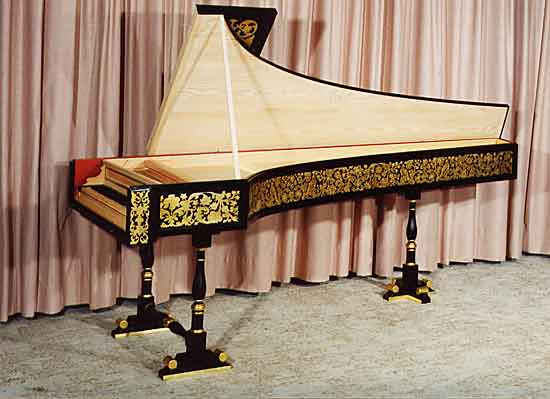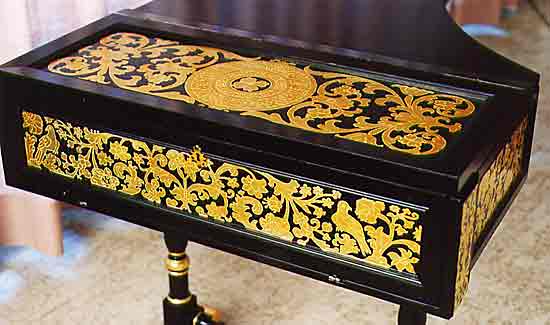SICILIAN HARPSICHORDS
Only a few Sicilian harpsichords have presently been identified and more investigation will yield a better view of this area of instrument making. Some of those which are presently thought to be Neapolitan may in fact have been made in Sicily.
A Sicilian harpsichord after the Royal College of Music no. 175
According to my most recent studies this instrument was probably made in Sicily and not Naples, as has been suggested. I offer a reconstruction of the original state of this instrument with its non-Pythagorean scaling that derives from the older 15th-century tradition, with an F,G-f³ compass. See 2002/2 "The design of an early..." in my Publications. A recent online article linking this with early harpsichord design in France and Germany appears at the publications section of the British Harpsichord Society.
A Sicilian harpsichord GG,AA-f³, 8'+8'
The model for this instrument has the faked inscription ascribing it to Celestini 1605 (in the Gemeentemuseum, The Hague; see 1989/2 "The 1605 Celestini..." in my Publications), but the origin appears to be Sicilian from about 1630. It is made as an inner-outer instrument with a maple case and spruce soundboard. The scalings are designed for 390 Hz using brass wire.
A Sicilian harpsichord by Grimaldi 1702, GG,AA-c³, 8'+8'
This instrument, now on display in the Musée de la Musique, Paris, France, is essentially the same design as the better-known 1697 model. I was commissioned by the museum to build a replica of this instrument in its original condition as a harpsichord since it was later fitted with a simple hammer action, which it was chosen to leave intact. My construction used the old principles of measurement and layout so that a replica of method was documented. A spruce soundboard and brass strings are used.

The decoration on the case was executed with an old technique that employed silver leaf over gesso and bole grounds and a changing varnish to make it appear like gold. This was commonly done since gold was more expensive than the labour required to apply it. Many pieces of antique "gold leaf" will be found on close inspection to be silver leaf with a changing varnish. In the Nuremberg instrument pieces of undissolved "Dragon's Blood", which imparts a reddish colour, can be seen in the varnish. The effect is more brilliant and reflects more light than the modern variant using transfer gold leaf.
